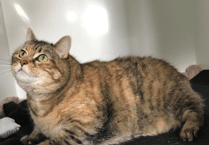In this week’s column, ManxSPCA general manager explains a cat’s ‘right to roam’ and introduces us to adorable Bruno...
Dusty, the grey and white cat, has been hitting the Manx headlines after her epic and unplanned journey to Devon last month. A familiar site around Nobles hospital, Dusty was seen getting into a white van, and then she promptly disappeared ... until she turned up, fit and well, a few days later but 400 miles away (presumably having been a stowaway in the van).
Dusty is now back on Manx soil, thanks to the fact that she is microchipped. Although it is a legal requirement in England for cats to be chipped, that is not the case in the Isle of Man. But Dusty’s story should prompt anyone with an unchipped cat to think again.
In law cats have a ‘right to roam’, and an owner is not legally responsible for where their cat wanders. And wander they do – it’s in a cat’s nature to explore their surroundings and mark their territory, particularly if they are not neutered or spayed. Hundreds of cats go missing on the Isle of Man every year, and if they were all chipped it would make reuniting them with their respective owners much simpler. It is easy and cheap to do (about £20): your veterinary practice can insert a chip, or alternatively you can bring your cat to our cattery and one of the team will undertake this quick, painless procedure. Please call ahead, though, on 851672 and use ‘option two’ to be taken through to the cattery telephone; and please leave a message on the answer machine if there’s no-one to take your call immediately.
A sure-fire way of encouraging a cat, whether it is lost or not, to stay in your garden or to come into your house is to feed it, and so this should be avoided even if the cat seems hungry or is a bit thin.
We receive lots of calls from people who don’t intentionally feed a stray cat but can’t avoid doing so because the cat comes through their cat flap and eats the food put down for the household cat. Most pet shops sell microchip-activated cat flaps which can be programmed to open only when your cat’s microchip is near it. These flaps cost about £50 but they are well worth it.
If you genuinely believe a visiting cat to be stray and in distress, place it in a cat box and take it to your local veterinary practice, or bring it to us at Ard Jerkyll, for ‘chip-checking’. Provided the microchip company has up-to-date owner’s details it should be fairly simple to reunite the cat with its family.
There are a few other things that help to ascertain whether a visiting cat has an owner. If the cat has the tip of one ear missing (a quarter of an inch, cut in a straight line, on the left ear), this means he or she has been neutered or spayed as a feral in the past and is still likely to be feral, and therefore won’t have an owner.

Although it may seem cruel, ear-tipping is an internationally recognised method of being able to check visually whether a feral cat has been neutered or spayed, without the need to trap it for closer inspection. This means that cats are not captured for a second time unnecessarily. It’s very difficult to tell if a female has been spayed and so ear-tipping prevents her being operated upon twice. The ear-tipping must be done by a vet, under general anaesthetic, and so discomfort for the cat is minimised.
But back to microchipping ... even though it is a legal requirement on the island to chip a dog, ten of the 29 dogs that have come into our rescue kennels so far this year have not been chipped. A worrying trend.
Adorable three-year-old Bruno was one of the ten ‘chip-less’ dogs, and he’s now looking for his new home with responsible and knowledgeable owners. Bruno is a Newfoundland cross poodle and he is, quite literally, a cuddly giant. He’s incredibly affectionate and a joy to be around, but he does have a strong prey drive and he sometimes forgets how big he is. His new owners will need to be able to handle a strong, bouncy dog and be committed to continuing his training.




.jpeg?width=209&height=140&crop=209:145,smart&quality=75)